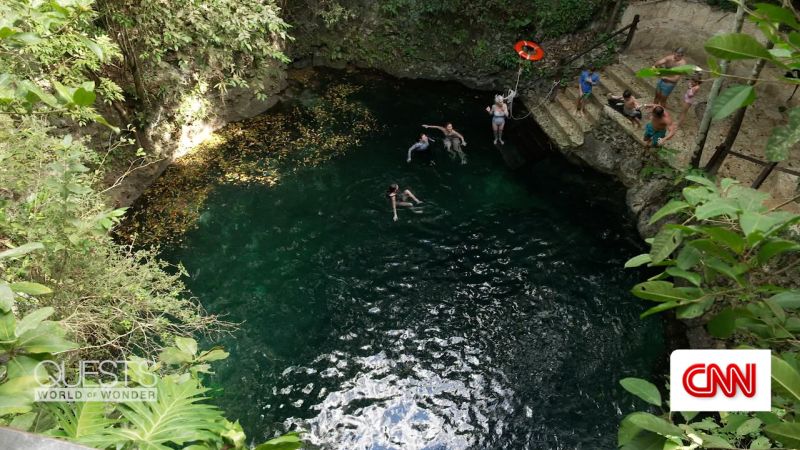Bindeman, I. et al. Silicic magma petrogenesis in Iceland by remelting of hydrothermally altered crust based on oxygen isotope diversity and disequilibria between zircon and magma with implications for MORB. Terra Nova 24, 227–232 (2012).
Marks, N., Zierenberg, R. A. & Schiffman, P. Strontium and oxygen isotopic profiles through 3 km of hydrothermally altered oceanic crust in the Reykjanes geothermal system, Iceland. Chem. Geol. 412, 34–47 (2015).
Johnson, T. E. et al. An impact melt origin for Earth’s oldest known evolved rocks. Nat. Geosci. 11, 795–799 (2018).
Bottke, W. F. & Norman, M. D. The Late Heavy Bombardment. Annu. Rev. Earth Planet. Sci. 45, 619–647 (2017).
Marchi, S. et al. Widespread mixing and burial of Earth’s Hadean crust by asteroid impacts. Nature 511, 578–582 (2014).
Flament, N., Coltice, N. & Rey, P. F. A case for late-Archaean continental emergence from thermal evolution models and hypsometry. Earth Planet. Sci. Lett. 275, 326–336 (2008).
Osinski, G. R. et al. Impact-generated hydrothermal systems on Earth and Mars. Icarus 224, 347–363 (2013).
Kring, D. A., Whitehouse, M. J. & Schmieder, M. Microbial sulfur isotope fractionation in the Chicxulub hydrothermal system. Astrobiology 21, 103–114 (2021).
Ingle, S. & Coffin, M. F. Impact origin for the greater Ontong Java Plateau? Earth Planet. Sci. Lett. 218, 123–134 (2004).
Jones, A. P., Wunemann, K. & Price, G. D. Modeling impact volcanism as a possible origin for the Ontong Java Plateau. Geol. Soc. Am. Spec. Pap. 388, 711–720 (2005).
Schmieder, M. & Kring, D. A. Earth’s impact events through geologic time: a list of recommended ages for terrestrial impact structures and deposits. Astrobiology 20, 91–141 (2020).
Johnson, T. E., Brown, M., Kaus, B. J. & VanTongeren, J. A. Delamination and recycling of Archaean crust caused by gravitational instabilities. Nat. Geosci. 7, 47–52 (2014).
Condie, K. in Earth’s Oldest Rocks (eds Van Kranendonk, M. et al.) 239–253 (Elsevier, 2019).
Dhuime, B., Hawkesworth, C. J., Cawood, P. A. & Storey, C. D. A change in the geodynamics of continental growth 3 billion years ago. Science 335, 1334–1336 (2012).
Korenaga, J. Was there land on the early Earth? Life 11, 1142 (2021).
Smithies, R. et al. Oxygen isotopes in zircon trace the origins of Earth’s earliest continental crust. Nature 592, 70–75 (2021).
Koeberl, C. The record of impact processes on the early Earth: a review of the first 2.5 billion years. Geol. Soc. Am. Spec. Pap. 405, 1–22 (2006).
Hansen, V. L. Impact origin of Archean cratons. Lithosphere 7, 563–578 (2015).
Salisbury, J. W. & Ronca, L. B. The origin of continents. Nature 210, 669–670 (1966).
Valley, J. W. et al. 4.4 billion years of crustal maturation: oxygen isotope ratios of magmatic zircon. Contrib. Mineral. Petr. 150, 561–580 (2005).
Bindeman, I. Oxygen isotopes in mantle and crustal magmas as revealed by single crystal analysis. Rev. Mineral. Geochem. 69 445–478 (2008).
Troch, J., Ellis, B. S., Harris, C., Bachmann, O. & Bindeman, I. N. Low-δ18O silicic magmas on Earth: a review. Earth-Sci. Rev. 208, 103299 (2020).
Hickman, A. H. East Pilbara Craton: A Record of One Billion Years in the Growth of Archean Continental Crust (Geological Survey of Western Australia, 2021).
Van Kranendonk, M. J., Kirkland, C. L. & Cliff, J. Oxygen isotopes in Pilbara Craton zircons support a global increase in crustal recycling at 3.2 Ga. Lithos 228–229, 90–98 (2015).
Petersson, A. et al. A new 3.59 Ga magmatic suite and a chondritic source to the east Pilbara Craton. Chem. Geol. 511, 51–70 (2019).
Pidgeon, R., Nemchin, A. & Whitehouse, M. J. The effect of weathering on U–Th–Pb and oxygen isotope systems of ancient zircons from the Jack Hills, Western Australia. Geochim. Cosmochim. Acta 197, 142–166 (2017).
Reimink, J. R., Chacko, T., Stern, R. A. & Heaman, L. M. Earth’s earliest evolved crust generated in an Iceland-like setting. Nat. Geosci. 7, 529–533 (2014).
Herzberg, C., Condie, K. & Korenaga, J. Thermal history of the Earth and its petrological expression. Earth Planet. Sci. Lett. 292, 79–88 (2010).
Sizova, E., Gerya, T., Stüwe, K. & Brown, M. Generation of felsic crust in the Archean: a geodynamic modeling perspective. Precambrian Res. 271, 198–224 (2015).
Hofmeister, A. M. Effect of a Hadean terrestrial magma ocean on crust and mantle evolution. J. Geophys. Res. 88, 4963–4983 (1983).
Johnson, T. E., Brown, M., Gardiner, N. J., Kirkland, C. L. & Smithies, R. H. Earth’s first stable continents did not form by subduction. Nature 543, 239–242 (2017).
Jones, A. P. Meteorite impacts as triggers to large igneous provinces. Elements 1, 277–281 (2005).
O’Neill, C., Marchi, S., Zhang, S. & Bottke, W. Impact-driven subduction on the Hadean Earth. Nat. Geosci. 10, 793–797 (2017).
Gerya, T. Precambrian geodynamics: concepts and models. Gondwana Res. 25, 442–463 (2014).
Herzberg, C. & Rudnick, R. Formation of cratonic lithosphere: an integrated thermal and petrological model. Lithos 149, 4–15 (2012).
Buick, R. et al. Record of emergent continental crust ∼3.5 billion years ago in the Pilbara Craton of Australia. Nature 375, 574–577 (1995).
Simonson, B. M., Davies, D. & Hassler, S. W. Discovery of a layer of probable impact melt spherules in the Late Archaean Jeerinah Formation, Fortescue Group, Western Australia. Aust. J. Earth Sci. 47, 315–325 (2000).
Simonson, B. M. et al. Geochemistry of 2.63–2.49 Ga impact spherule layers and implications for stratigraphic correlations and impact processes. Precambrian Res. 175, 51–76 (2009).
Gamal El Dien, H. et al. The largest plagiogranite on Earth formed by re-melting of juvenile proto-continental crust. Commun. Earth Environ. 2, 1–16 (2021).
Bindeman, I. N. & Valley, J. W. Formation of low-δ18O rhyolites after caldera collapse at Yellowstone, Wyoming, USA. Geology 28, 719–722 (2000).
Bindeman, I. N. & Valley, J. W. Low-δ18O rhyolites from Yellowstone: magmatic evolution based on analyses of zircons and individual phenocrysts. J. Petrol. 42, 1491–1517 (2001).
Byerly, B. L., Kareem, K., Bao, H. & Byerly, G. R. Early Earth mantle heterogeneity revealed by light oxygen isotopes of Archaean komatiites. Nat. Geosci. 10, 871–875 (2017).
Puchtel, I. S. et al. Insights into early Earth from Barberton komatiites: evidence from lithophile isotope and trace element systematics. Geochim. Cosmochim. Acta 108, 63–90 (2013).
Salerno, R., Vervoort, J., Fisher, C., Kemp, A. & Roberts, N. The coupled Hf–Nd isotope record of the early Earth in the Pilbara Craton. Earth Planet. Sci. Lett. 572, 117139 (2021).
Murphy, D. et al. Combined Sm-Nd, Lu-Hf, and 142Nd study of Paleoarchean basalts from the East Pilbara Terrane, Western Australia. Chem. Geol. 578, 120301 (2021).
Hartnady, M. I., Kirkland, C. L., Smithies, R. H., Johnson, S. P. & Johnson, T. E. Pb isotope insight into the formation of the Earth’s first stable continents. Earth Planet. Sci. Lett. 578, 117319 (2022).
Kerr, A. C. & Mahoney, J. J. Oceanic plateaus: problematic plumes, potential paradigms. Chem. Geol. 241, 332–353 (2007).
Kring, D. A. et al. Probing the hydrothermal system of the Chicxulub impact crater. Sci. Adv. 6, eaaz3053 (2020).
Fagereng, Å., Harris, C., La Grange, M. & Stevens, G. Stable isotope study of the Archaean rocks of the Vredefort impact structure, central Kaapvaal Craton, South Africa. Contrib. Mineral. Petr. 155, 63–78 (2008).
Reimink, J. R., Chacko, T., Stern, R. A. & Heaman, L. M. The birth of a cratonic nucleus: lithogeochemical evolution of the 4.02–2.94 Ga Acasta Gneiss Complex. Precambrian Res. 281, 453–472 (2016).
Bauer, A. et al. Hafnium isotopes in zircons document the gradual onset of mobile-lid tectonics. Geochem. Perspect. Lett. 14, 1–6 (2020).
Mojzsis, S. J. et al. Evidence for life on Earth before 3,800 million years ago. Nature 384, 55–59 (1996).
Osinski, G. R., Cockell, C. S., Pontefract, A. & Sapers, H. M. The role of meteorite impacts in the origin of life. Astrobiology 20, 1121–1149 (2020).
Bottke, W. F. et al. An Archaean heavy bombardment from a destabilized extension of the asteroid belt. Nature 485, 78–81 (2012).
Martin, D. M. B., Hocking, R. M., Riganti, A. & Tyler, I. M. Geological Map of Western Australia 1:2 500 000 (Geological Survey of Western Australia, 2015).
Wingate, M. & Johnson, S. 216545: metatonalite, Mujee Pool; Geochronology Record 1566 (Geological Survey of Western Australia, 2019).
Wingate, M. & Johnson, S. 216594: metatonalite, Mujee Pool; Geochronology Record 1567 (Geological Survey of Western Australia, 2019).
Pidgeon, R., Nemchin, A. & Cliff, J. Interaction of weathering solutions with oxygen and U–Pb isotopic systems of radiation-damaged zircon from an Archean granite, Darling Range Batholith, Western Australia. Contrib. Mineral. Petr. 166, 511–523 (2013).
Black, L. P. et al. Improved 206Pb/238U microprobe geochronology by the monitoring of a trace-element-related matrix effect; SHRIMP, ID–TIMS, ELA–ICP–MS and oxygen isotope documentation for a series of zircon standards. Chem. Geol. 205, 115–140 (2004).
Nasdala, L. et al. Zircon M257—a homogeneous natural reference material for the ion microprobe U‐Pb analysis of zircon. Geostand. Geoanal. Res. 32, 247–265 (2008).
Cavosie, A. J. et al. The origin of high δ18O zircons: marbles, megacrysts, and metamorphism. Contrib. Mineral. Petr. 162, 961–974 (2011).
Morris, P. A. Composition of Geological Survey of Western Australia Geochemical Reference Materials (Geological Survey of Western Australia, 2000).
Hammerli, J., Kemp, A. I. & Jeon, H. An Archean Yellowstone? Evidence from extremely low δ18O in zircons preserved in granulites of the Yilgarn Craton, Western Australia. Geology 46, 411–414 (2018).
Hiess, J., Bennett, V. C., Nutman, A. P. & Williams, I. S. In situ U-Pb, O and Hf isotopic compositions of zircon and olivine from Eoarchaean rocks, West Greenland: new insights to making old crust. Geochim. Cosmochim. Acta 73, 4489–4516 (2009).
King, E. M., Valley, J. W., Davis, D. W. & Edwards, G. R. Oxygen isotope ratios of Archean plutonic zircons from granite-greenstone belts of the Superior Province: indicator of magmatic source. Precambrian Res. 92, 365–387 (1998).
Whitehouse, M. J., Nemchin, A. A. & Pidgeon, R. T. What can Hadean detrital zircon really tell us? A critical evaluation of their geochronology with implications for the interpretation of oxygen and hafnium isotopes. Gondwana Res. 51, 78–91 (2017).







More News
Judge dismisses superconductivity physicist’s lawsuit against university
Future of Humanity Institute shuts: what’s next for ‘deep future’ research?
Star Formation Shut Down by Multiphase Gas Outflow in a Galaxy at a Redshift of 2.45 – Nature